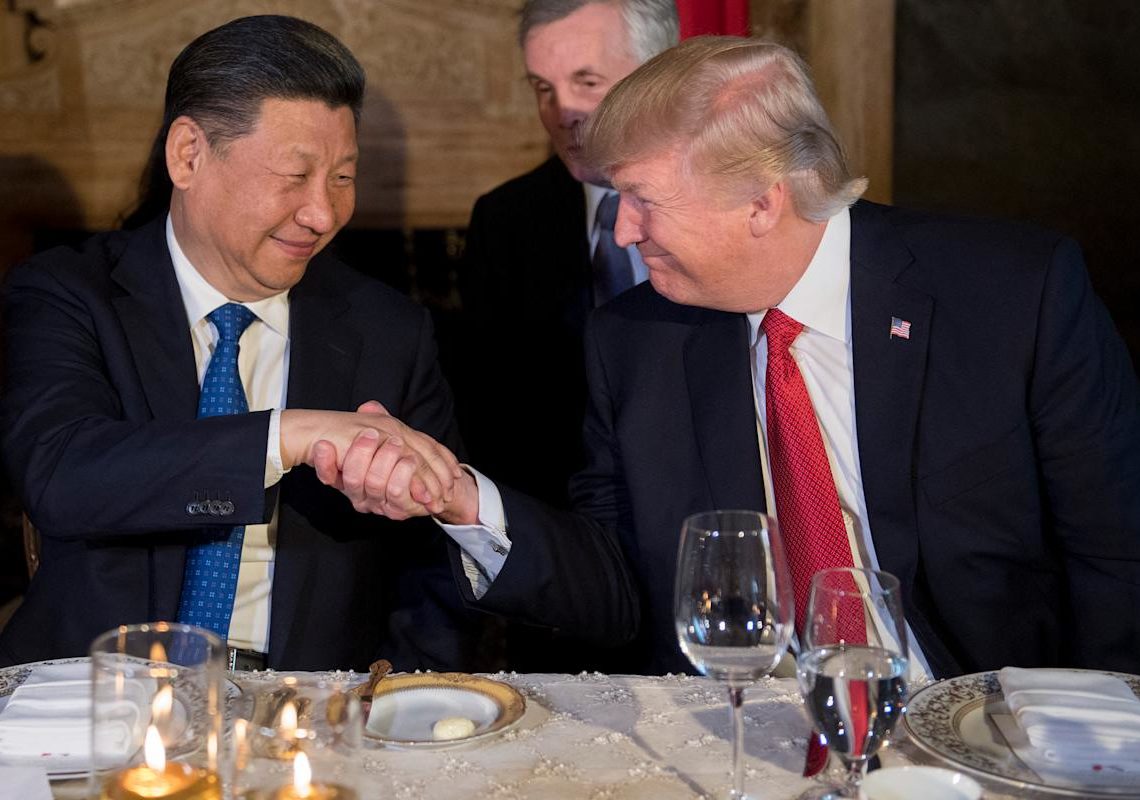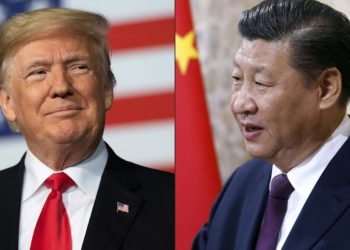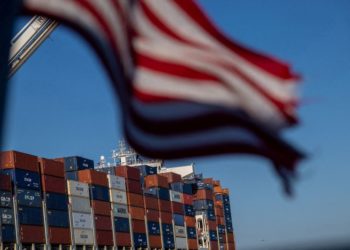President Donald Trump wants Chinese leader Xi Jinping to call. Making trade deals with China’s neighbors is part of a broader White House strategy to get him to the negotiating table.
As the two countries face off in a bitter trade war, the administration’s current theory of the case, which has been circulating among Trump allies and was confirmed by a White House official, is that tariff deals with Asian countries, as well as the dozens of others across the globe seeking to negotiate with the U.S., will isolate China, disrupt the Chinese supply chain and threaten to cut the country off from the rest of the world.
The White House sees the wave of announcements from companies moving manufacturing operations to the U.S. and its broader sectoral-based tariff strategy as key components in getting Xi to cooperate as well, said the official, who like others in this story was granted anonymity to discuss the administration’s strategy.
“Once you see a lot of countries — not just in southeast Asia or Asia, but all over — you’ll see that they’re willing to make deals with America, and that exerts pressure on China to hopefully come to the table,” the official said. “Because China’s economy is reliant on a lot of these other countries around the world, I think once people see, hopefully, deals being struck with these countries, that exerts pressure on China.”
But even people close to the White House — who want to see Trump succeed, China crippled and manufacturing boom in the U.S. — are unsure the strategy will work. Some argue cutting deals with other countries is at odds with the president’s broader America First approach on trade, which seeks to restore U.S. manufacturing, while using tariffs as a stick to eke out leverage. Others see those deals as a necessary stopgap as the U.S. works to reshore manufacturing.
“The tough balance is the fact that we get money because of tariffs, but we want to pick and choose which countries to have free trade with. We want to appear to be going towards free trade but we also love the revenue from tariffs,” said a second White House official.
Trump allies also note China has been preparing for another trade war with the United States for years, pointing to the measures China is implementing to inflict its own form of pressure on the U.S., such as retaliatory tariffs and other bureaucratic obstacles. They also acknowledge China, as an authoritarian government, will likely have more success in urging its citizens to withstand temporary pain than the U.S. would.
Deals with allies in Asia could take time, a luxury jittery bond markets may not afford the president. And even if they do manifest, there’s no guarantee that they would hem in China, which has proven adept at dodging U.S. tariffs in the past.
“The theory is, get all of Asia but China to the table, incentivize them with lower tariffs and U.S. companies will leave China,” said one person close to the White House. “And yes it makes sense. It’s happening already. But is it enough to move China? Big question.”
Two different people close to the White House said Trump, not a deputy, is leading the administration’s strategy on China, which has in some cases left people outside the White House without a point person to go to.
“This is one of those areas where Trump is on his own,” said another person close to the White House. “Unlike the first term, there aren’t a lot of, or any, really, I think dissenting voices on the overall picture.”
Asked who is leading the White House’s negotiations on China, a third person close to the White House quipped: “A junior staffer named Donald Trump.”
So far, the administration is shooting blanks in its strategy of pushing Beijing into de-escalation through its sky-high 145 percent tariff on Chinese imports.
Beijing has punched back with both a 125 percent retaliatory tariff and a suite of non-tariff import curbs calculated to inflict pain across a swathe of economic sectors. They include bureaucratic obstacles to agricultural and energy imports, a travel advisory aimed at kneecapping Chinese tourist arrivals to the U.S. and — per a Bloomberg report Tuesday — halting delivery of Boeing aircraft.
Trump could leverage similar non-tariff trade weapons targeting potentially vulnerable Chinese export sectors to push Beijing into talks. That could include import quotas on Chinese steel or textiles, requiring U.S. importers to get government licenses for procuring Chinese exports to the U.S. or imposing new U.S. safety, labeling, or environmental standards for Chinese products, said Harry Broadman, a former assistant U.S. trade representative in the George H.W. Bush and Bill Clinton administrations.
But Beijing’s defiance so far suggests that those tactics may be as unsuccessful as steep tariffs.
“The bigger question is what gets the two sides to the negotiating table — is there anything left to do that would constitute an escalation that’s more signal than noise? No,” said Marc Busch, who advised both USTR and the Commerce Department on technical trade barriers during the Obama and first Trump administrations, and is now a professor of international business diplomacy at Georgetown University.
Instead, Beijing has leveraged global frustration with Trump as an opportunity to make inroads with both Europe and its East Asian neighbors.
China signed dozens of cooperation agreements with Vietnam on Monday as Xi sweeps across southeast Asia, where he will also visit Malaysia and Cambodia, two countries that risk getting hit especially hard by the return of Trump’s so-called reciprocal tariffs. Meanwhile, top Japanese officials are set to meet with U.S. trade negotiators in Washington on Wednesday.
“If you’re Vietnam or Cambodia or Malaysia you have to recognize that we’re in a heavyweight battle now between China and the United States and Trump is probably not going to back down,” said Thomas Duesterberg, a senior fellow at the Hudson Institute.
Still, he said, these countries should be realistic about China and its economy.
“The southeast Asians have to understand that Xi is not going to change the operating macroeconomic model in China, which is based on overproduction and exports,” he said.
Henrietta Levin, former deputy China director at the State Department during the Biden administration, said she did not expect Trump’s efforts to pressure China to the table would work.
“In today’s China, strategic decisions are first of all of course made by one man, by Chinese President Xi Jinping,” she said. “He cares about his own political dignity and national greatness in a way that overshadows more tactical considerations.”
It’s a challenge that Trump allies acknowledge. While Trump also cares about his own personal image, he lacks the control over the American people that Xi has over the Chinese, and can’t simply urge them to embrace austerity in the hope of a better America down the road. It’s a point that was underscored by the administration’s announcement on Friday that consumer electronics would be carved out from the hefty reciprocal tariffs on China, and by Trump’s own post on Truth Social Tuesday suggesting future relief to help American farmers weather the tariffs.
“The strategy is the classic Trump playbook — use leverage, be tough, go to the mat, don’t blink,” said one former Trump administration official. “Although he blinked already, which really does harm his credibility on these things.”
Derek Scissors, a senior fellow at the American Enterprise Institute and chief economist of the China Beige Book, said, “it should surprise nobody that Trump is just backing down.”
“He’s never wanted to confront the Chinese. So we had a few days where it looked like he wanted to confront the Chinese and people should not have taken that seriously. Could it happen? Yes, if everything goes wrong,” Scissors said. “But his inclination is to bluster a great deal and then back off.”
Intent on not being seen as caving by making the first move, Trump telegraphed a growing desperation to engage with Xi by sending White House press secretary Karoline Leavitt into the briefing room on Tuesday with a dictated message for the Chinese leader.
“The ball is in China’s court. China needs to make a deal with us. We don’t have to make a deal with them. There’s no difference between China and any other country, except they are much larger, and China wants what we have — what every country wants — what we have, the American consumer,” Leavitt said, reading from Trump’s prepared statement. “Or, put another way, they need our money.”
Interestingly, JP Morgan Chase CEO Jamie Dimon, whose recession worries helped spur Trump to dial back tariffs last week, applied new pressure in an interview on Tuesday, urging Trump and Xi to begin talks sooner rather than later.
“It doesn’t have to wait a year,” Dimon said of U.S.-China talks in a sit-down with the Financial Times. “It could start tomorrow.”
Eli Stokols, Dasha Burns, and Daniel Desrochers contributed to this report.
The post Trump wants to make a deal with China. Here’s how he’s trying to make that happen. appeared first on Politico.




